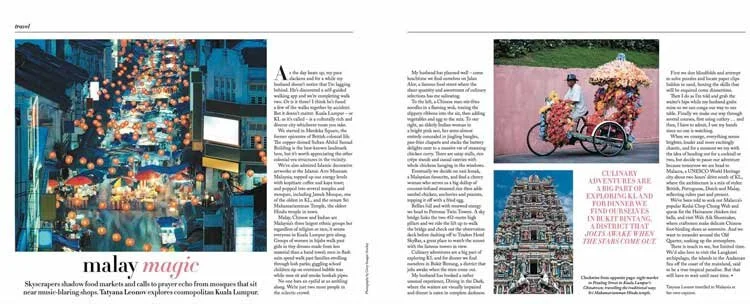Malay Magic
Skyscrapers shadow food markets and calls to prayer echo from mosques that sit near music-blaring shops. Tatyana Leonov explores cosmopolitan Kuala Lumpur.
As the day heats up, my pace slackens and for a while my husband doesn’t notice that I’m lagging behind. He’s discovered a self-guided walking app and we’re completing walk two. Or is it three? I think he’s fused a few of the walks together by accident. But it doesn’t matter. Kuala Lumpur – or KL as it’s called – is a culturally rich and diverse city whichever route you take.
We started in Merdeka Square, the former epicentre of British colonial life. The copper-domed Sultan Abdul Samad Building is the best-known landmark here, but it’s worth appreciating the other colonial-era structures in the vicinity.
We’ve also admired Islamic decorative artworks at the Islamic Arts Museum Malaysia; topped up our energy levels with kopitiam coffee and kaya toast; and popped into several temples and mosques, including Jamek Mosque, one of the oldest in KL, and the ornate Sri Mahamariamman Temple, the oldest Hindu temple in town.
Malay, Chinese and Indian are Malaysia’s three largest ethnic groups but regardless of religion or race, it seems everyone in Kuala Lumpur gets along. Groups of women in hijabs walk past girls in tiny dresses made from less material than a hand towel; men in flash suits speed walk past families strolling through lush parks; giggling school children sip on oversized bubble teas while men sit and smoke hookah pipes.
No one bats an eyelid at us ambling along. We’re just two more people in the eclectic crowd.
My husband has planned well – come lunchtime we find ourselves on Jalan Alor, a famous food street where the sheer quantity and assortment of culinary selections has me salivating.
To the left, a Chinese man stir-fries noodles in a flaming wok, tossing the slippery ribbons into the air, then adding vegetables and egg to the mix. To our right, an elderly Indian woman in
a bright pink sari, her arms almost entirely concealed in jingling bangles, pan-fries chapatis and stacks the buttery delights next to a massive vat of steaming chicken curry. There are satay stalls, rice crêpe stands and casual eateries with whole chickens hanging in the windows.
Eventually we decide on nasi lemak, a Malaysian favourite, and find a cheery woman who serves us a big dollop of coconut-infused steamed rice then adds sambal chicken, anchovies and peanuts, topping it off with a fried egg.
Bellies full and with renewed energy we head to Petronas Twin Towers. A sky bridge links the two 452-metre high pillars and we ride the lift up to walk the bridge and check out the observation deck before dashing off to Traders Hotel SkyBar, a great place to watch the sunset with the famous towers in view.
Culinary adventures are a big part of exploring KL and for dinner we find ourselves in Bukit Bintang, a district that jolts awake when the stars come out.
My husband has booked a rather unusual experience, Dining in the Dark, where the waiters are visually impaired and dinner is eaten in complete darkness.
Clockwise from opposite page: night market in Petaling Street in Kuala Lumpur’s Chinatown; travelling the traditional way; Sri Mahamariamman Hindu temple.
First we don blindfolds and attempt to solve puzzles and locate paper clips hidden in sand, honing the skills that will be required come dinnertime.
Then I do as I’m told and grab the waiter’s hips while my husband grabs mine so we can conga our way to our table. Finally we make our way through several courses, first using cutlery ... and then, I have to admit, I use my hands since no one is watching.
When we emerge, everything seems brighter, louder and more excitingly chaotic, and for a moment we toy with the idea of heading out for a cocktail or two, but decide to pause our adventure because tomorrow we are head to Malacca, a UNESCO World Heritage city about two hours’ drive south of KL, where the architecture is a mix of styles: British, Portuguese, Dutch and Malay, reflecting rulers past and present.
We’ve been told to seek out Malacca’s popular Kedai Chop Chung Wah and queue for the Hainanese chicken rice balls, and visit Wah Aik Shoemaker, where craftsmen make delicate Chinese foot-binding shoes as souvenirs. And we want to meander around the Old Quarter, soaking up the atmosphere.
There is much to see, but limited time. We’d also love to visit the Langkawi archipelago, the islands in the Andaman Sea off the coast of the mainland, said to be a true tropical paradise. But that will have to wait until next time.
Tatyana Leonov travelled to Malaysia at her own expense.






